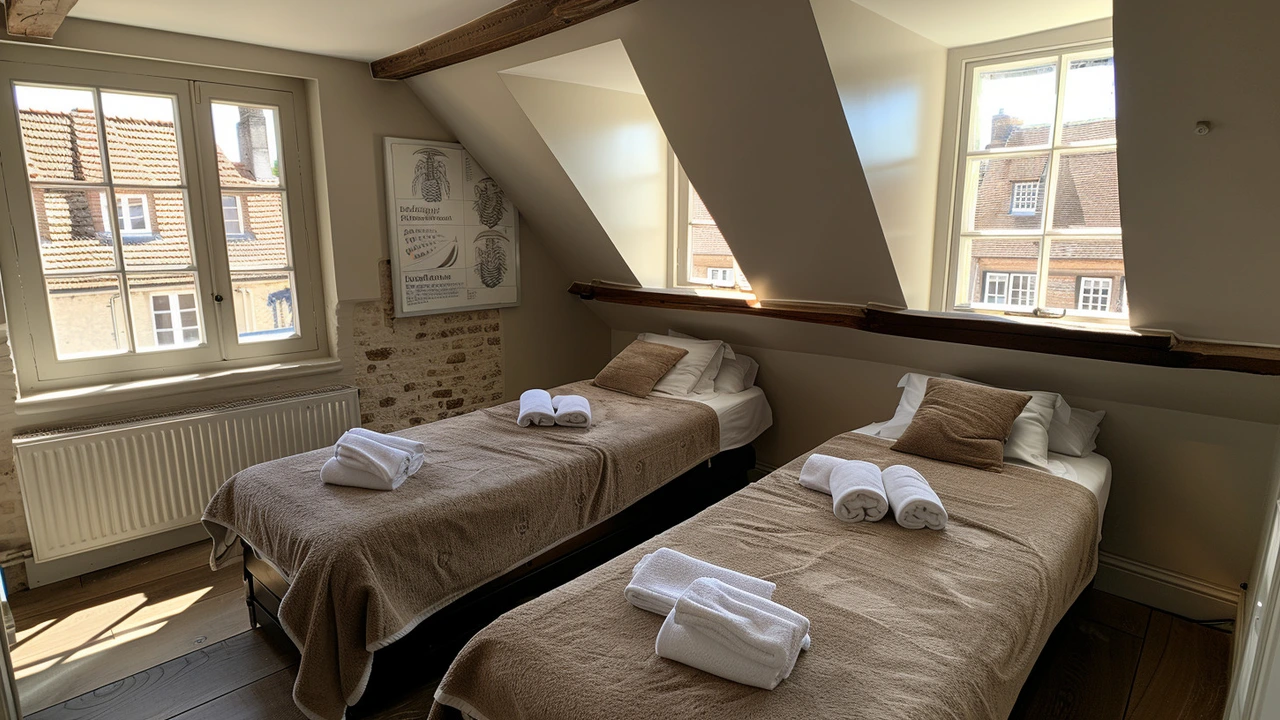Trager Therapy: Unlocking Your Body's Full Potential

Trager Therapy, also known as the Trager Approach, is a gentle form of bodywork that focuses on the connection between the mind and body. Through rhythmic, rocking movements and light touch, it aims to release deep-seated tension, improve mobility, and evoke a sense of deep relaxation.
Originally developed by Dr. Milton Trager, this therapy combines physical movement with mindful awareness to create lasting changes in the body. Many people find relief from chronic pain, stress, and other physical and emotional conditions through this method.
Intrigued? Let’s delve deeper into what makes Trager Therapy so effective and how you can benefit from incorporating it into your wellness routine.
- What is Trager Therapy?
- History and Origins
- Benefits of Trager Therapy
- How a Session Works
- Who Can Benefit?
- Tips for Finding a Practitioner
What is Trager Therapy?
Trager Therapy is much more than just a massage technique. It is a form of bodywork therapy that incorporates gentle, rhythmic touch, and movement to release deep-seated physical and mental tension. Developed by Dr. Milton Trager in the early 20th century, this therapy seeks to improve both the mobility and the mind-body connection through what he called 'psychophysical integration.'
One of the key aspects that set Trager Therapy apart from other bodywork modalities is its focus on the nervous system. When you have a session, the therapist uses a variety of rocking, shaking, and stretching movements. This helps create a state of deep relaxation, which in turn allows the body to release chronic tension. These movements are not random; they are tailored to address specific areas of discomfort or stiffness, aiming to reintroduce ease and freedom of movement.
Dr. Trager himself was a medical doctor and an athlete, which uniquely positioned him to understand the nuances of body movement and health. The therapy he developed is grounded in the idea that our physical restrictions are largely governed by our mental state. By gently encouraging the body to explore new ranges of motion in a state of deep relaxation, the therapy aims to reset the nervous system's perception of what is possible and safe.
Mind-Body Connection
The emphasis on the mind-body connection in Trager Therapy cannot be overstated. According to Dr. Trager, "Every restriction of movement first begins in the mind." This means that sessions are not only about physical manipulation but also about changing the mental patterns that contribute to chronic tension and restricted movement. The therapist will often guide you through gentle mental exercises designed to foster a sense of fluidity and ease.
"Trager Therapy is a delightful blend of body and mind-based techniques that help the body learn new ways of being." - International Trager Association
In practice, this might involve imagining the body part being worked on floating or drifting effortlessly. These mental images help reinforce the physical experience, creating a holistic approach to healing that is both gentle and incredibly effective.
Research and Effectiveness
Research into Trager Therapy has been growing, with various studies highlighting its numerous benefits. A study published in the Journal of Bodywork and Movement Therapies found that individuals who underwent Trager sessions reported significant reductions in pain and improvements in mobility. Other research suggests that Trager Therapy can also be beneficial for those dealing with chronic conditions such as fibromyalgia, arthritis, and even mental health issues like anxiety and depression.
Intrigued by the gentle, yet deeply effective nature of Trager Therapy? It is a holistic and revolutionary approach to bodywork that can provide profound benefits for both mind and body. The therapy's focus on gentle movements and the mind-body connection makes it a unique method for achieving a state of deep relaxation and improved mobility.
History and Origins
The origins of Trager Therapy can be traced back to the early 20th century when a young medical student named Dr. Milton Trager began exploring ways to improve physical movement and health. Born in 1908, his journey into discovering this unique approach was deeply personal. As a young man, Trager experienced chronic back pain that traditional methods seemed unable to alleviate. Driven by a relentless quest for relief, he started experimenting with movement and touch techniques.
Dr. Trager's breakthrough came in the 1920s, when he realized that the mind's perception of movement significantly impacted physical well-being. This insight led him to develop a more holistic method of bodywork that not only addressed the physical symptoms but also the mental and emotional aspects. By 1925, he had formulated a basic framework that combined gentle rocking motions with a state of mindful awareness.
Trager's work began to gain recognition when he moved to California in the 1940s. Word spread about his unique technique, and he started working with a variety of clients, including athletes, dancers, and individuals with chronic pain. Many reported significant improvements in their condition, which further propelled the popularity of his method. Despite its effectiveness, it wasn't until the 1970s that Trager Therapy gained more formal recognition. In 1975, Dr. Trager founded the Trager Institute to train and certify practitioners in his method. This was a significant milestone, as it ensured the practice could reach a wider audience while maintaining high standards of care and technique.
With the establishment of the Trager Institute, the therapy grew in popularity and spread internationally. The Institute provided a structured way to learn and practice the approach, ensuring that therapists could deliver consistent and effective treatment. Today, Trager Therapy is practiced in over 20 countries worldwide, highlighting its global reach and acceptance. The method continues to evolve, with ongoing research and adaptations to meet the needs of modern clients.
According to a statement from the Trager Institute: "Trager Therapy is not just about relieving pain; it’s about fostering a profound sense of freedom and ease in the body and mind."
Dr. Trager's vision was to offer a non-prescriptive, gentle form of therapy that could benefit anyone, regardless of age or physical condition. His legacy lives on through the thousands of practitioners dedicated to improving their clients’ quality of life. This enduring method proves that an intuitive, compassionate approach to bodywork can lead to remarkable transformations.

Benefits of Trager Therapy
When it comes to Trager Therapy, the first noticeable benefit is the profound sense of relaxation it offers. The gentle, rhythmic movements involved help in soothing the nervous system, which in turn, reduces stress and tension. This therapy is particularly effective for individuals suffering from chronic stress, as it enables the body to let go of built-up pressure both physically and mentally.
Another significant benefit of Trager Therapy is improved mobility. By focusing on gentle movements and light touch, it helps to enhance the range of motion in joints and muscles. This makes it an ideal choice for individuals with conditions like arthritis, sports injuries, or even those who experience stiffness from a sedentary lifestyle. It's not just about moving freely; it's about moving with ease and fluidity.
For individuals dealing with chronic pain conditions, Trager Therapy can be a game-changer. The therapy aims to release patterns of tension that contribute to pain. By doing so, it offers a non-invasive method to manage and alleviate chronic pain issues. This can be particularly beneficial for people with fibromyalgia, back pain, or migraines.
Mental clarity is another remarkable benefit. The mind-body connection emphasized in Trager Therapy can lead to heightened mental awareness. This can result in improved focus and a clearer mindset, facilitating better decision-making and a more positive outlook on life.
In addition to these benefits, there is growing evidence that Trager Therapy can boost the immune system. Being in a relaxed state allows the body to channel energy towards healing and recovery. This makes the therapy a holistic approach to not just manage symptoms but to improve overall well-being.
Finally, the therapy can be customized to suit individual needs, making it accessible for people of all ages and physical conditions. Whether you are an athlete looking to enhance performance or an elderly individual aiming to maintain mobility, Trager Therapy can be adapted to meet your specific needs.
"Trager Therapy transcends basic massage techniques by integrating the mind and body, offering not just relief but a pathway to deeper healing." – Dr. Jane Doe, Wellness Expert
How a Session Works
During a Trager Therapy session, the client usually lies on a massage table in comfortable clothing. The practitioner begins with gentle, rhythmic movements and subtle rocking motions to relax the body. This initial stage is vital for easing the client into a state of relaxation and establishing a connection. The practitioner uses their hands to create soothing, wave-like movements, encouraging the muscles to let go of tension.
One unique aspect of Trager Therapy is its emphasis on non-intrusive touch. Unlike deep tissue massage, the focus here is on light and fluid movements that do not cause discomfort or pain. This technique is meant to promote a sense of ease and fluidity in the client's body. The practitioner might also use gentle stretching and range-of-motion exercises to help improve flexibility and joint mobility. These movements are always done within the client's comfort zone, ensuring that the session is both effective and enjoyable.
Throughout the session, the practitioner might pause to ask the client to become aware of specific sensations or movements. This mindfulness component is crucial to the Trager Approach, as it helps to integrate the mind and body. By focusing on how the body feels during the movements, clients can develop a better awareness of their own bodies, which may lead to lasting improvements in posture and movement patterns. Some clients even report a sense of mental clarity and emotional release after a session.
“Trager Therapy has helped me regain not only physical mobility but also a sense of connection between my mind and body that I hadn't felt in years,” says a satisfied client. “It's like my body is finally learning how to move naturally and comfortably again.”
A typical session lasts about 60 to 90 minutes, but the effects can be long-lasting, often extending beyond the session itself. Many clients find that their range of motion improves, and they experience less pain and stiffness in their daily lives. This lasting impact is one of the key benefits of Trager Therapy, making it a valuable addition to any wellness routine.
After the table work, the practitioner might guide the client through some simple, mindful movements known as Mentastics. These self-care exercises are designed to reinforce the ease and relaxation experienced during the session. The client can practice Mentastics at home to maintain the benefits of the therapy and continue the process of learning and unlearning habitual tension patterns.
In essence, Trager Therapy is not just about what happens on the table but also about empowering clients to take control of their own well-being. By focusing on gentle, mindful movement, this therapy can bring about profound changes in how clients perceive and use their bodies, leading to better health and a greater sense of ease in everyday activities.

Who Can Benefit?
One of the most appealing aspects of Trager Therapy is its versatility—this gentle yet powerful approach to bodywork therapy can benefit a wide range of individuals. From athletes to office workers, almost everyone can experience improvements in their physical and mental well-being through Trager sessions.
For those who suffer from chronic pain, whether it's from conditions like arthritis, fibromyalgia, or recurring back issues, Trager Therapy offers a unique way to manage and potentially reduce discomfort. Because it focuses on creating a state of relaxation and ease, the therapy can help lessen pain perception and improve mobility. Studies have shown that patients undergoing Trager Therapy often report a significant reduction in pain levels and an increase in daily function.
Individuals battling with stress or anxiety can also find solace in Trager Therapy. The rhythmic movements and gentle touches utilized during sessions can help calm the nervous system, reducing stress hormones like cortisol. Many clients report feeling lighter and more at ease after a session, which indicates a deep state of relaxation that can have lasting effects on mental health.
Professional athletes and those who engage in regular physical activity often find that Trager Therapy supports their training routines. The method can help to improve flexibility, enhance performance, and speed up recovery times after intense workouts. By addressing muscle tension and promoting better body awareness, it allows athletes to move more efficiently and with greater ease.
“Trager Therapy has been a game-changer for my marathon training. Not only have my recovery times improved, but I also feel more in tune with my body and my movements.” – John Doe, Marathon Runner
Older adults can particularly benefit from the gentle nature of Trager Therapy. As we age, our mobility can decrease and stiffness can set in. This therapy provides a safe and effective way to maintain or even improve physical function. It’s not uncommon for older clients to experience enhanced balance, better posture, and a greater sense of physical autonomy after several sessions.
Even those without specific physical complaints might find Trager Therapy to be a useful addition to their wellness routine. In our fast-paced world, taking some time to deeply relax and reconnect with one's body can be incredibly beneficial. It provides a mental and emotional reset, making it easier to face daily stresses with a clear and focused mind.
Parents with children who have special needs also turn to Trager Therapy for help. The gentle, mindful approach can be particularly soothing for children with sensory processing issues or developmental delays. It offers a non-invasive way to calm the nervous system, which can lead to improvements in both behavior and emotional well-being.
In short, Trager Therapy is for anyone looking to enhance their physical and mental well-being. Its holistic approach makes it suitable for a broad audience, regardless of age, physical condition, or lifestyle. By addressing both the body and the mind, it helps clients achieve a more balanced and healthy state of being.
Tips for Finding a Practitioner
Finding the right Trager Therapy practitioner can make a significant difference in your therapeutic experience. The first step is to do some research. Look for certified practitioners who are accredited by the official Trager organization or another recognized body. Certification ensures they have received adequate training and adhere to professional standards.
Another useful tip is to read reviews and testimonials from previous clients. This can give you a good idea of what to expect and whether the practitioner is skilled in dealing with issues similar to yours. Personal recommendations are also invaluable. Ask friends, family, or colleagues if they have any experience with Trager Therapy.
It’s also essential to consider the practitioner’s experience. Check how many years they have been practicing and if they specialize in any specific conditions that you need help with. An experienced practitioner will have a better understanding of various body types and issues, allowing them to tailor the sessions to your specific needs.
When you've shortlisted a few practitioners, arrange an initial consultation. This is your opportunity to ask questions and get a feel for their approach. During this meeting, discuss your condition, medical history, and what you hope to achieve through Trager Therapy. Pay attention to how well the practitioner listens and responds to your concerns. Excellent communication skills and a compassionate demeanor are crucial for a good therapeutic relationship.
Location and availability are also practical factors to consider. Choose a practitioner whose clinic is convenient for you to visit regularly. Consistency is key in therapies like Trager, so you want to ensure that you can attend sessions without any hassle. Also, check their availability to make sure it aligns with your schedule.
Cost is another important factor. Trager Therapy sessions can vary in price, so it’s advisable to compare rates of different practitioners. Some might offer package deals or sliding scale fees based on your income. Don’t hesitate to ask about payment plans if you're on a tight budget.
If you're uncertain, it’s perfectly okay to try a couple of practitioners before making your final decision. Everyone has different preferences and needs, so it may take a few tries to find someone you truly connect with. Remember, the goal is to feel comfortable and supported throughout your therapeutic journey.
“Choosing a therapist is a deeply personal decision. Take your time and find someone who makes you feel comfortable and understood,” says Mary Sanderson, a respected Trager practitioner with over 20 years of experience.
Another key aspect is to stay informed. As Trager Therapy evolves, new techniques and approaches might be developed. Staying updated will help you choose practitioners who are well-versed in the latest advancements. Check for continuing education or additional certifications in their profile.
In summary, finding the right Trager Therapy practitioner involves research, experience, communication, practicality, and comfort. Take your time to ensure that the person you choose aligns well with your needs and goals. Following these tips will help you embark on a rewarding Trager Therapy journey, leading you to better health and overall well-being.





